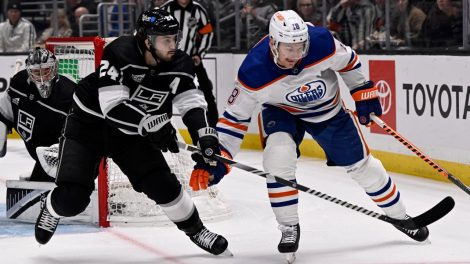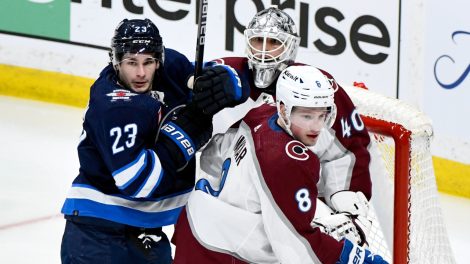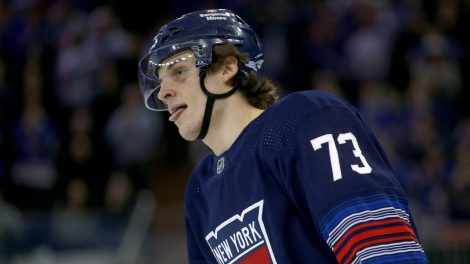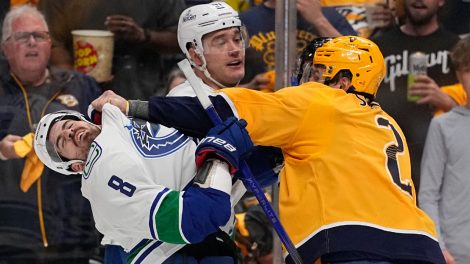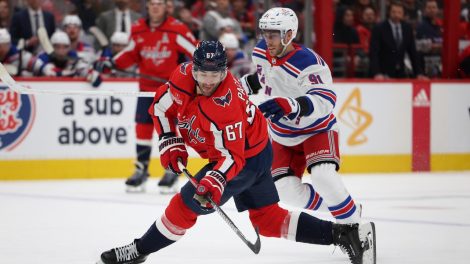We’ve been using statistical analysis to rank the best players in the NHL at their positions, and until now things have been mostly similar for all the skaters, with statistics having different weights for each position. However when it comes to goaltending, everything goes out the window.
POSITIONAL TOP 20 RANKINGS: Centre | Right Wing | Left Wing | Defence
Goaltending analytics are in their infancy compared to other areas of hockey, and those who are experts in statistical analysis for skaters often don’t fully understand goaltending. Because of this, I reached out to two goaltending experts who I trust to break down how to build a worthwhile model for ranking goalies: Chris Boyle from the Shot Quality Project, and Paul Campbell from InGoal Magazine.
As with the other rankings, everything will be out of 100 points, except this time the categories are much different. The three areas I wanted to look at with goaltending were performance, consistency, and degree of difficulty. The weightings that were agreed upon were 50 points for performance, 20 for consistency, and 30 for difficulty.
To be considered for this list, a goalie must have started a minimum of 75 games over the past three seasons, with statistics collected from NHL.com, hockey-reference.com, and Sportlogiq.
For the goaltending position, the statistics used in each category were;
Performance: 5-vs-5 save percentage, 5-vs-4 save percentage, 4-vs-5 save percentage, and inner slot save percentage.
Consistency: Quality start percentage, percentage of possible starts that were started, and really bad start percentage (starts with a save percentage below .850).
Difficulty: 5-vs-5 scoring chances against per 60, 5-vs-4 scoring chances against per 60, 4-vs-5 scoring chances against per 60, team high danger passes (slot, off the rush, East-West) against per 60, expected save percentage based on shot location, and rebound loose puck recovery rate.
Before we get into it, I want to stress that the weightings of the statistics inside each category are my own, and as such, this list is by no means definitive.
20: Jonathan Quick | Performance: 32.73/50 | Consistency: 12.05/20 | Difficulty: 9.99/30 | Total: 54.78/100
When we were ranking skaters, we looked at each player’s biggest strengths based on data, but unfortunately that kind of data doesn’t really exist for goaltenders. For better or worse (mostly worse) almost all goaltender evaluation is based around various kinds of save percentage, so when looking at goalies we have to use a bit more eye test analysis to see what makes them unique.
Fortunately, Quick is a very easy goalie to watch and see what makes him special — his agility, reflexes, and power side-to-side. Quick is possibly the most entertaining goalie to watch in modern hockey, however that doesn’t always translate into actually being good. Quick is incredibly athletic, boasting ridiculous speed and reflexes, but he often lacks control in his game that elite goaltenders have to keep them out of trouble. Luckily for him, no team allows fewer dangerous passes against than the Los Angeles Kings, and they’re amazing at picking up his rebounds. This allows Quick to be explosive on initial shots, and rarely be caught out of position.
19: Petr Mrazek | Performance: 34.14/50 | Consistency: 12.01/20 | Difficulty: 9.79/30 | Total: 55.95/100
The only goaltender in the top-20 with a lower degree of difficulty than Quick, Mrazek has played behind a very stingy Red Wings team in terms of shot locations and pre-shot movement at even strength. With that said, his performance level is above average for a starting goaltender, as is his consistency, and he can still improve at 24 years old. Mrazek is a bit like Quick in that he’s a little too aggressive in his crease, and relies on reflexes more than he should.
18: Marc-Andre Fleury | Performance: 31.78/50 | Consistency: 12.31/20 | Difficulty: 12.03/30 | Total: 56.12/100
Fleury is probably the goalie who gets made fun of most by fans around the league, thanks to four straight sub-.900 save percentage playoff performances from 2010 to 2013, but he’s been a very reliable goaltender over the past three seasons. You may see a pattern here, but like Quick and Mrazek, Fleury is an athletic goalie who relies more on his power and reflexes than he should at times, but he has kept himself more contained in recent years, shoring up his positioning and learning to play within himself.
17: Jaroslav Halak | Performance: 27.88/50 | Consistency: 12.77/20 | Difficulty: 15.96/30 | Total: 56.61/100
Halak is a totally different goaltender than the others we’ve looked at so far. And while he hasn’t hit the high performance levels of the three goaltenders ranked lower, he has been more consistent in a much more difficult situation, which has value. Halak is one of the smallest goalies in the NHL, the only smaller regular is Jhonas Enroth, and he needs to be much more technically sound in order to cover as much net as possible. Sealing the bottom of the net is Halak’s biggest strength, but his high danger save percentage is very low, likely due in part to his size disadvantage. When players get a clean look in close, there’s just a bit more net to shoot at with Halak, and they can take advantage more often.
16: Michal Neuvirth | Performance: 34.60/50 | Consistency: 8.94/20 | Difficulty: 13.13/30 | Total: 56.67/100
Last season Neuvirth finally broke out of the box he’s been put in as a career backup, showing himself as someone who has the potential to at least be a lead platoon goalie with around 45-50 starts. Unfortunately Neuvirth hasn’t proven capable of playing that much and maintaining his performance yet, so potential is all we can call it. Neuvirth plays a very controlled game, with solid positioning and technical skills, but he can fall apart periodically for long stretches, which has hampered his career so far.
15: Ryan Miller | Performance: 26.67/50 | Consistency: 11.07/20 | Difficulty: 22.08/30 | Total: 59.82/100
When Miller signed in Vancouver, do you think he knew what he was getting into? In his mid-30s Miller has looked like an average to below average goaltender, but his degree of difficulty has been immense. At his peak Miller was the prime example of a goalie maximizing athleticism and solid positioning, and while some of his speed has left him with age, he’s still very capable.
14: Sergei Bobrovsky | Performance: 29.81/50 | Consistency: 13.69/20 | Difficulty: 17.54/30 | Total: 61.05/100
Hampered by multiple groin injuries over the past several years, Bobrovsky has been on a continual downward spiral in terms of year-over-year performance. However, this season he appears to be healthy, and while matching his Vezina year seems pretty unlikely, we might see Bob reassert himself as one of the better goaltenders in the NHL.
13: Roberto Luongo | Performance: 35.85/50 | Consistency: 12.99/20 | Difficulty: 12.30/30 | Total: 61.14/100
Luongo provided the stabilizing influence on the back end necessary for the Panthers to become a serious contender, but while his numbers are still very good, at 37 years old it’s tough for Luongo to be a world-beater. While he has been a top-three goaltender in the league for most of his career, you can see some inconsistency creeping into his game now, as he’s only mid-range in terms of quality starts, and his mobility isn’t what it used to be. He has done an excellent job adjusting his game to account for age and injuries though; he is truly under-appreciated over the past decade and a half.
12: Thomas Greiss | Performance: 36.65/50 | Consistency: 8.89/20 | Difficulty: 15.96/30 | Total: 61.50/100
Another goaltender who emerged as more than just a backup last season, Greiss has put up extraordinarily strong numbers in limited action for several years, including the second-best inner slot save percentage in the NHL. What’s perhaps most interesting about Greiss though, is that he just doesn’t blow games. He’s only mid-range in quality starts, but he gave up the second-fewest really bad starts per game started over the past three years in the NHL. Part of that could be a small sample size advantage, but Greiss is a player who deserves a chance to prove it isn’t.
11: Steve Mason | Performance: 35.20/50 | Consistency: 13.19/20 | Difficulty: 13.13/30 | Total: 61.52/100
From rookie of the year, to punch line, to analytics community darling, Mason has done it all. He has had a career renaissance in Philadelphia, fixing major positioning and overreaction problems in his game. Strong and big, Mason covers a lot of net, but puck tracking through traffic was a big problem early in his career. He seems to have made major strides there and has also cut down his over-activity in the crease. Goaltending is a very delicate balance of playing percentages and reacting quickly — two things it looks like Mason has figured out. Curiously, many people think the Flyers make it tougher for Mason defensively, but they’re actually above average in that area.
10: Ben Bishop | Performance: 35.38/50 | Consistency: 15.16/20 | Difficulty: 12.48/30 | Total: 63.01/100
A giant in the net at 6-foot-7, Bishop is unique as a monster goalie who moves very well. Bishop’s size and mobility has been a big factor in his success in short-handed situations, boasting the best save percentage in the NHL there over the past three seasons. While Bishop is an excellent goaltender, he also faces easier shots than most goalies, as the Lightning are among the best teams in the NHL at keeping shots against outside the slot and stopping teams from making high danger passes.
9: Braden Holtby | Performance: 35.60/50 | Consistency: 15.62/20 | Difficulty: 12.84/30 | Total: 64.06/100
Last season’s Vezina winner is ranked lower than most would think. A big factor in that is how efficient the Capitals have become defensively, especially in stopping high danger passes — only the Kings, Sharks, and Red Wings are better. Holtby is a remarkable technical goaltender and cutting down on pre-shot movement allows him to get set for more of his shots faced, boosting his save percentage.
8: Brian Elliott | Performance: 36.98/50 | Consistency: 13.20/20 | Difficulty: 14.96/30 | Total: 65.14/100
Underrated for years, Elliott has continually put up among the best save percentages in the league. But in a way, he is a tale of two goaltenders. He has among the highest rate of quality starts in the entire NHL, but he’s also shown the propensity to get blown out more often than most starting goaltenders. That makes Elliott look like more of a risk to coaches, hence why he has struggled to hold down a starting role, even though on the whole he is far more likely to win you a game than lose one.
7: Tuukka Rask | Performance: 34.67/50 | Consistency: 15.60/20 | Difficulty: 15.38/30 | Total: 65.65/100
Rask is what a lot of pundits believe Quick is; an athletic goaltender with ridiculous reflexes who can steal wins with an exceptional all-around game. Rask benefited from a suffocating Bruins’ defensive scheme for years, but that has fallen apart recently with the aging of Zdeno Chara, and the losses of players such as Johnny Boychuk. That change has led to Rask’s numbers dropping significantly, but don’t sleep on him, he’s still great.
6: Cory Schneider | Performance: 37.36/50 | Consistency: 16.62/20 | Difficulty: 15.51/30 | Total: 69.48/100
One of the NHL’s save percentage kings, Schneider has the second-highest level of performance in the NHL over the past three seasons, and has been the third-most consistent. However his degree of difficulty is lower than the top of the pack. There isn’t really a bad word to say about Schneider, his technique is essentially flawless, he’s an excellent puck tracker, and only the next goalie on the list has a higher chance of giving you a quality start.
5: Corey Crawford | Performance: 36.50/50 | Consistency: 17.96/20 | Difficulty: 15.15/30 | Total: 69.61/100
I’ve been a big doubter of Crawford, but the facts are the facts in this case. No goalie in the NHL over the past three seasons has been as consistent as Crawford, with the highest rate of quality starts, and his numbers are excellent overall. The Blackhawks’ defensive structure is strong, and keeps pre-shot movement to a minimum, but even when they do break down, Crawford has the fifth-highest high danger save percentage in the league.
4: Cam Talbot | Performance: 36.04/50 | Consistency: 10.61/20 | Difficulty: 23.07/30 | Total: 69.72/100
Probably the biggest surprise on the list, Talbot has played behind two brutal defensive teams in Edmonton and New York, but despite that his numbers have been strong. The sample size is small on Talbot so far, but putting up an above league average save percentage behind the Oilers’ defence last year without Oscar Klefbom was extremely impressive for his first season as a starting goaltender. Whether Talbot can keep his performance on that level going forward is the big question for the Oilers.
3: Semyon Varlamov | Performance: 32.14/50 | Consistency: 14.77/20 | Difficulty: 23.79/30 | Total: 70.71/100
Despite an off year last season, Varlamov has put up decent numbers behind an Avalanche team that seemed to not at all understand what to do in their own zone. No goalie has faced more scoring chances the past three seasons than Varlamov, yet he has remained a top-end starter, even earning a nomination for the Vezina Trophy.
2: Henrik Lundqvist | Performance: 34.87/50 | Consistency: 16.04/20 | Difficulty: 25.46/30 | Total: 76.38/100
There’s a huge gap between the second- and third-best goaltender in the NHL, and that gap represents the difference between great goalies, and franchise altering ones. It’s worth noting that in his career, Lundqvist has never had a below league average season. Most goalies have at least one disaster season, but Hank just shows up and plays 60 games with a .920+ save percentage every year like clockwork. It’s remarkable.
Even more impressive is that he has maintained that level of play as the Rangers have turned into a complete mess defensively and he’s moved out of his prime years. Lundqvist plays very different than most other goaltenders, preferring to stay tight to his net to minimize the need for dramatic side-to-side pushes, and reducing the chances of being caught out of position. Playing deep like that does open up more net to shoot at for opponents, but Lundqvist copes with that due to phenomenal puck tracking, anticipation, and reflexes.
1: Carey Price | Performance: 48.10/50 | Consistency: 17.23/20 | Difficulty: 18.81/30 | Total: 84.13/100
Another huge gap separates the top two goaltenders, as Price has been far and away the best goaltender in the NHL for a while now. The gap in performance between Price and the next best goaltender is gargantuan. For example, the difference between Price and the next-best goaltender in save percentage over the past three seasons is equivalent to the difference between the second place goalie and 17th. The same thing for even strength save percentage is equivalent to the difference between the second-best goaltender and 22nd. Price’s performance level the past three years is a whole different world in goaltending. He hasn’t faced Lundqvist-level degree of difficulty, but he still faces the fifth-toughest shots in the league, and we’ve seen what happens when he’s not around to stop them.


